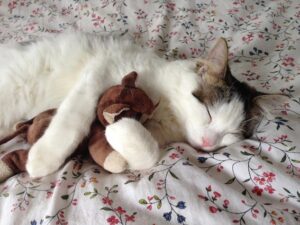
Cats are incredibly flexible and capable of various postures.
As a result, their sleeping and sitting styles are diverse, with interesting names such as "Nyamonite" and "Kobako-zuwari" (box sitting).
However, the various poses cats take are not just cute.
They can also give us insights into a cat's psychology and health condition.
In this article, we will introduce the types of sleeping and sitting styles of cats and what we can learn from them.
Table of Contents
1. What can we learn from a cat's sleeping and sitting styles?
∟1-1. Whether it's hot or cold
∟1-2. Whether they are relaxed or on alert
∟1-3. Health condition
∟1-4. Habits and preferences
2. Sleeping styles and the feelings and conditions of cats
∟2-1. Nyamonite
∟2-2. Gomen-ne (apology sleeping)
∟2-3. Lying on the side
∟2-4. Belly up
3. Sitting styles and the feelings and conditions of cats
∟3-1. Kobako-zuwari (box sitting)
∟3-2. Sphinx sitting
∟3-3. Egyptian sitting
∟3-4. Scottish Fold sitting
Summary
1. What can we learn from a cat's sleeping and sitting styles?
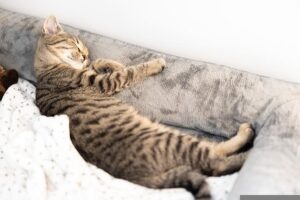
Cats may not speak, but their body language is quite rich.
Just by observing a cat's sleeping and sitting styles, we can uncover many things hidden inside them.
1-1. Whether it's hot or cold
Cats are sensitive to temperature changes and are geniuses at finding comfortable spots and postures.
When it's hot, they stretch out in well-ventilated places, and when it's cold, they curl up in warm spots.
From a cat's sleeping and sitting styles, we can tell if a cat is feeling hot or cold.
Let's adjust the room temperature to make them comfortable.
1-2. Whether they are relaxed or on alert
From a cat's sleeping and sitting styles, we can also tell if they are relaxed or on alert.
Simplifying, if they are in a posture that allows them to quickly stand up, they are on alert; if they are sprawled out, they are in a relaxed state.
It might be a little shocking to see them in an alert posture, but as we will introduce later, they have their preferences, so there's no need to worry.
1-3. Health condition
From a cat's sleeping and sitting styles, we can also understand their health condition. Especially, the following states require attention:
- ・Always sitting or sleeping in a different place
- ・Having a different sitting or sleeping style
By checking your cat's usual sleeping and sitting styles, you can detect their discomfort early.
Also, the "Scottish Fold sitting" often seen in Scottish Folds might be due to health issues.
We will introduce more details later.
1-4. Habits and preferences
Seeing a cat in an alert posture or in a strange posture might make you worry if they are not relaxed or if they are unwell.
However, it could simply be that they prefer that sleeping or sitting style, or they have a habit of adopting unique poses different from other cats.
Just like some people prefer to relax in a reclining seat while others prefer to sit up straight with a right-angle backrest, cats also have various habits and preferences.
If your cat is happy every day, there's no problem at all.
2. Sleeping styles and the feelings and conditions of cats
When sleeping, animals are most vulnerable.
The posture they adopt at that time can give us an honest insight into the cat's feelings and condition.
Let's introduce the commonly seen sleeping styles of cats and what we can learn about their feelings and condition from them.
2-1. Nyamonite
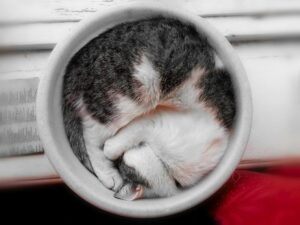
"Nyamonite" refers to a sleeping style where cats curl up into a ball.
This name was given because their appearance resembles an ammonite.
When cats sleep in this style, it's generally because they are feeling "cold."
Typically, when the room temperature falls below 13°C, they feel "cold" and tend to curl up to sleep.
Even when curled up, the position of the head and the direction of the legs can tell us whether they are on alert or relaxed.
When the head is raised, resting on their feet, and the soles of their feet are touching the ground, it means they are "on alert."
They adopt this posture to be able to look around quickly and escape if necessary.
Conversely, when the head is flat on the ground and the legs are sprawled out, it indicates relaxation.
If you see a cat curled up, checking their head and legs might be interesting.
2-2. Gomen-ne (apology sleeping)
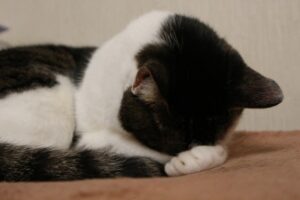
Sometimes they sleep hiding their face with their front legs.
Because they look like they are apologizing when lying face down and covering their face, this is called "Gomen-ne" (apology sleeping).
There are various theories about why they sleep this way, but the following three are commonly mentioned:
・Bright light
Cats have highly sensitive eyes to light, and they may find the room's light too bright, making it hard to sleep.
It's similar to humans sleeping with an eye mask.
Dimming the room's light a bit or taking them to a darker room might make it easier for them to sleep.
・Wanting to feel secure
Cats like tight spaces.
By covering their face with their hands, they create a tight space, which might make them feel secure.
・Cold
Cats and dogs cover their noses with their tails when it's cold.
This protects their bare nose and warms their breath, shielding them from the cold.
Similarly, covering their face with their hands might also be because they are cold.
2-3. Lying on the side
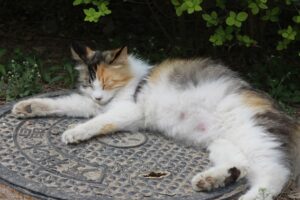
They also adopt a posture that looks like they are lying on their side or sitting, with their legs thrown out.
This is a posture cats take when they are feeling peaceful.
Especially when their front legs are not touching the floor and are thrown out, it indicates they are quite relaxed.
2-4. Belly up
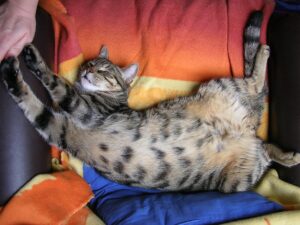
When cats lie on their back with their belly up (towards the sky), it's called "Belly up."
This is a sleeping style that indicates a 100% relaxation level.
For cats, the belly is the most vulnerable part. Exposing it openly while sleeping indicates they are in a state of complete trust and relaxation.
Additionally, sleeping belly up also indicates they are feeling "hot."
As a guideline, they tend to sleep belly up when the temperature exceeds 21°C.
Seeing a cat sleep belly up leisurely is a summer spectacle, although some may see it all year round.
3. Sitting styles and the feelings and conditions of cats
Even when they seem to be sitting casually, we can infer various things from their posture.
Let's introduce the common sitting styles of cats and what we can understand about their feelings and condition from them.
3-1. Kobako-zuwari (box sitting)
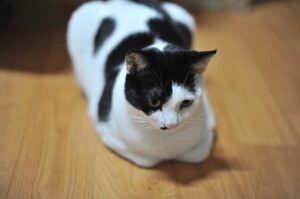
"Kobako-zuwari" (box sitting) is a sitting style where the cat tucks its belly, front legs, and back legs under its body, hiding them.
This creates a neat box shape, resembling the "kobako" used in tea ceremony and flower arranging to store incense, hence the name "Kobako-zuwari."
In English, it's called "catloaf."
Since the front legs don't touch the floor in Kobako-zuwari, they can't move quickly.
Therefore, this sitting style is adopted when they are relaxed.
Especially, they often do this Kobako-zuwari in safe places like tight or high spots.
3-2. Sphinx sitting
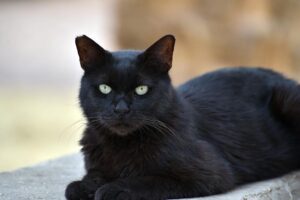
Sphinx sitting is when a cat places its belly on the ground and stretches its front legs forward.
It's named because it resembles a sphinx.
Unlike Kobako-zuwari, the front legs in Sphinx sitting are on the floor and stretched forward, ready to move at any moment.
Therefore, it's a posture adopted when they are "tense" or "eager to move."
When a cat is in Sphinx sitting, check its face.
If its ears are perked up and its eyes sparkle with curiosity, it might be awaiting something fun and is ready to leap into action.
It might be a good idea to entice them with a toy at such times.
3-3. Egyptian sitting
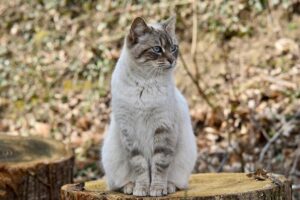
Egyptian sitting is when a cat sits with its hind legs spread forward while keeping its front legs upright.
This posture is named "Egyptian sitting" because it reminds us of the Egyptian cat goddess Bastet.
By sitting in the Egyptian posture, the cat's face is elevated, allowing it to have a wide view, indicating it is on alert or interested in something.
When a cat sits by the window looking outside, it often adopts the Egyptian sitting posture, raising its face to gather as much information as possible.
Similarly, wrapping the tail neatly around the front legs, known as "tail-wrapping sitting," is also done when on alert, for warmth, or to keep the tail clean, among other reasons.
3-4. Scottish Fold sitting
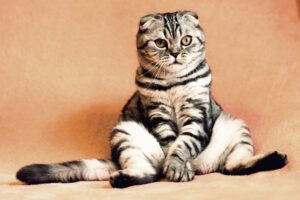
Scottish Fold sitting is when a cat sits like a human, with its buttocks down and hind legs thrown forward.
It's called Scottish Fold sitting because it's a common posture for Scottish Folds.
Although it might look cute, this sitting style might indicate a health issue.
The folded ears characteristic of Scottish Folds are due to a genetic condition called osteochondrodysplasia.
This condition might also affect other parts of the body, causing pain and leading to the Scottish Fold sitting posture for relief.
However, some cats might adopt this sitting style out of habit or preference, so it's not always indicative of pain.
If concerned, closely observe the cat and consult a veterinarian.
Summary
We introduced the sleeping and sitting styles of cats and what we can learn about their feelings and conditions from them.
The cute sleeping and sitting styles of cats are filled with messages from them.
While enjoying these adorable postures, let's interpret the psychology and health condition of our cats and make sure they spend their days comfortably.


